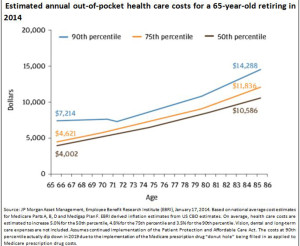27 May Wealth ≠ Health
At Maclendon we work with our members to obtain their long term goals. With that, we have the responsibility to educate our members on the risks that can adversely affect their portfolios. Traditionally this includes interest rate risk, currency risk, investment style risk, and concentration risk to name a few. But one risk that is not nearly as talked about and sometimes “overlooked” could have a drastic effect on your retirement if not adequately planned for – healthcare costs. According to a recent study from AARP, 55% of working Americans older than 50 believe they will not have enough money for healthcare in retirement. Even more astonishing is that 38% say they haven’t saved anything for such expenses. If this survey is accurate, there is going to be a harsh reality check with many retirees.
Checkup
Healthcare costs have drastically risen over the past 25 years. Although we have seen growth decelerate from the historical rate of 7.2% from 1990 through 2008, the Centers for Medicare and Medicaid Services expect growth will average 6% from 2015 to 2023. To put this in perspective, a couple retiring in 2015 is expected to need over $250,000 in today’s dollars to cover healthcare costs in retirement. For the younger generation we could see that number double in 12 years.

To better understand the potential effects of rising healthcare costs on your portfolio it is important to understand the costs involved. So what do healthcare costs include? They consist of copays and premiums for Medicare, Medigap, retiree health insurance, and other services not covered by Medicare such as dental care, vision care and hearing aids. In addition, the possibility of needing long-term care in a nursing facility can cost hundreds of thousands of dollars which can quickly deplete your retirement assets. All of these costs can not only deplete your portfolio assets, but can entirely derail your retirement.
In addition, people are living longer. Life expectancy of Americans has dramatically risen. Based on analysis done by the Social Security Administration there is a 47% chance that one spouse will live to age 90 or beyond if they are 65 years old today. This equates to the fact that retirees will have to save more to avoid outliving their assets and the probability of a major health event increases.
At Maclendon, it is common for capital preservation to be the main objective in retirement. We take into consideration future expenses, including healthcare costs, when developing a member’s financial plan. There are many ways to plan for rising healthcare costs, but like most plans, the sooner you have one the better. Factoring in healthcare expenses has increasingly become a critical part of retirement planning. Fortunately, there are steps you can do now to help you avoid the potential sticker shock of costs in the future.
Rx
First you should be aware of your options. Educate yourself and be aware of what you need and the cost for that coverage. Know the different deductibles, co-pays, or other limitations. This will not only give you peace of mind, but will also help your advisor determine how much to set aside for future healthcare costs when developing your financial plan.
Taking into consideration future health care costs allows for a more realistic assessment of retirement cash flow needs, which can increase the likelihood of a successful financial plan.
You can also create additional financial security with the purchase of long term care insurance. It is estimated that at least 70% of people over 65 will need long term care services at some point. With the national median cost of one year in a private nursing home room to be about $87,600 and the yearly cost of a home health aide working 44 hours a week is $45,188, it is no wonder why long term care can provide a needed benefit to protecting your assets. Unfortunately, fewer than 3% of American adults have purchased a long term care insurance policy. This could be because of the lack of planning or foresight with respect to healthcare costs in the future. Insurance can be perceived to be just an expense as many do not see the value until they actually need it. At that point it is too late and the damage will already be done as you are forced to take additional withdrawals to cover the expenses. In addition, delaying the purchase of long term care can prove to be costly. Typically the younger you establish coverage the lower your premiums will be, but will also be based on your health, elimination period, benefit amount, and other factors.
One of the easiest ways to save on healthcare costs is of course to live a healthy lifestyle and emphasize proactive preventative healthcare. Although we cannot control family history or genetic dispositions, we can control our diet and lifestyle. The many benefits of not smoking, eating healthy, and exercising regularly reaches far beyond your well-being. You can also significantly decrease your healthcare costs and avoid being a part of the group who drives up the overall cost of healthcare. It is estimated that people who live a healthy lifestyle save hundreds of dollars a year in medical expenses and preventative healthcare can save billions of dollars annually.
As with any risk to your portfolio the best plan of action is to have a plan. The sooner you plan, the more likely it will be successful. As healthcare costs continue to grow and the probability of becoming a major expense in retirement increases, you must take actions now to protect your future.



